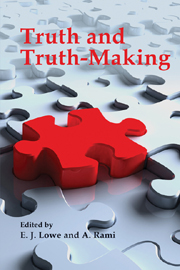Book contents
- Frontmatter
- Contents
- Preface
- Contributors
- 1 Introduction: truth and truth-making
- Part I Setting the stage
- Part II The current debate
- 8 Truth-making and correspondence
- 9 Facts and relations: the matter of ontology and of truth-making
- 10 Being and truth
- 11 An essentialist approach to truth-making
- 12 Are there irreducibly relational facts?
- 13 Why truth-makers
- 14 Postscript to “Why truth-makers”
- Bibliography
- Index
14 - Postscript to “Why truth-makers”
from Part II - The current debate
- Frontmatter
- Contents
- Preface
- Contributors
- 1 Introduction: truth and truth-making
- Part I Setting the stage
- Part II The current debate
- 8 Truth-making and correspondence
- 9 Facts and relations: the matter of ontology and of truth-making
- 10 Being and truth
- 11 An essentialist approach to truth-making
- 12 Are there irreducibly relational facts?
- 13 Why truth-makers
- 14 Postscript to “Why truth-makers”
- Bibliography
- Index
Summary
In this chapter I shall reply to a pair of articles in which the main contention of my “Why truth-makers” – namely, that an important class of synthetic true propositions have entities as truth-makers – is rejected. In §§1–5 I reply to Jennifer Hornsby's “Truth without Truthmaking Entities” (2005) and in §§6–7 I reply to Julian Dodd's “Negative Truths and Truthmaker Principles” (2007).
In §1 of her paper Hornsby writes that I express my premise that truth is grounded in various ways. One of these, which she calls ‘(G2)’, is this:
(G2) The truth of <the rose is red> is explained [/determined] by the rose's being red.
When she later on refers to (G2), she refers mainly to the formulation in terms of ‘explained by’. In a footnote Hornsby writes that she is quoting almost verbatim as far as possible (2005: 34 n.3). Now although I said that one explains the truth of <the rose is red> in terms of the rose's being red, I did not mean this to be a way of expressing the idea that truth is grounded. Indeed I made this claim about explanation in the paragraph preceding the one where I say there are many ways of expressing the idea that truth is grounded (this vol., Ch. 13, 231). What I had in mind is that this fact about explanation is a consequence of the fact that the truth of <the rose is red> is determined by the rose's being red.
Information
- Type
- Chapter
- Information
- Truth and Truth-Making , pp. 242 - 250Publisher: Acumen PublishingPrint publication year: 2008
Accessibility standard: Unknown
Why this information is here
This section outlines the accessibility features of this content - including support for screen readers, full keyboard navigation and high-contrast display options. This may not be relevant for you.Accessibility Information
- 1
- Cited by
